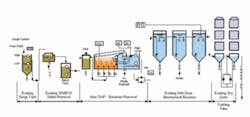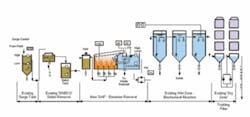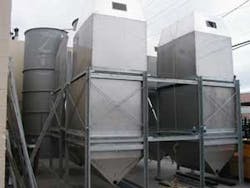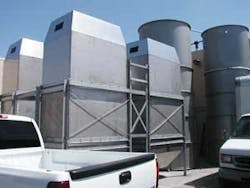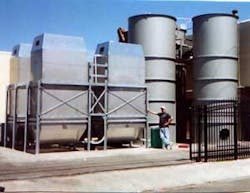Tortilla Flats: Biological Filtration System Gives Bay Area Business Room to Grow
Jesus Villareal and his brother run the family business, La Mexicana, a tortilla factory in Hayward, Calif., with a little cornmeal, starch, water and a touch of salt.
Actually, it’s quite a lot of those ingredients.
“We go through I’m gonna guess 10,000 to 12,000 pounds of cornmeal a day,” said Jesus, the company president. “On some days, it can go as high as 18,000 pounds. We’re not huge by any standard. I know some big companies that produce probably 10 times what we do. A lot in California and some in Texas do that volume - a couple in Phoenix.”
The San Francisco Bay area business south of Oakland was started by one of Villareal’s father’s uncles in 1965 and his family took it over in 1970. He became president in 1983. Today, it employs more than 30 people. His brother, Jose, is vice president. “He’s my right hand man,” Jesus said. “We do pretty much everything between the two of us.”
And at 10,000 square feet, the La Mexicana building isn’t big, so everything in it has to be done efficiently. So, when they were confronted with a challenge by the city to lower the amount of waste they were putting into the sewers, they had to think creatively.
Cramping Their Style
The wastewater treatment system for the city of Hayward, which has grown a lot in recent years, was being taxed by the BOD5 load from enterprises like La Mexicana and began to crack down. It pulled the company’s sewer permit and was demanding a reconnection fee. Based on the BOD5 levels, that was going to be around $800,000 as a one-time fee or the business could pay monthly surcharges of $10,000 to $12,000 - “forever, or as long as I was putting wastewater into the system.”
This was in late 2001. Villareal read an article from a water conservation publication about a large tortilla plant in Texas, La Fama, that had worked with a Canadian company, Dry Biofilter (DBF) Inc., of Mississagua, Ontario, to reduce its BOD5 load from the facility’s wastewater. Villareal contacted the company and, after some preliminary research, DBF president Don Prazmowski, and a partner in U.S. affiliate DBF USA Inc., Steve Mechler, in San Antonio, Texas, came out to see what they could do.
Villareal pointed out, “They themselves, the city staff, gave me the article and said, ‘If you could bring your BOD levels down, we could probably reduce the one-time charge quite a bit. If you could bring it from 17,000 BOD, we could drop it to $280,000. And if you dropped it to 200, there would be no charges - or under 1,000 for highly reduced charges.’”
DBF’s first successful commercial installation of its DBF Wastewater Treatment System (WTS) was completed in 1989 for Heinz in Ontario and New Jersey. It later began working with meat processing facilities in both Canada and the United States and has had particular success with bakeries and tortilla plants.
“Tortilla producers are essentially bakeries and, at La Mexicana, while the wastewater volume was relatively low, its strength was very high. As a result, La Mexicana was discharging to the sewer organic loading equivalent to a bakery at least 20 times larger,” Prazmowski said.
Smaller and Faster
He said the treatment process his company employs functions much the same as a conventional municipal wastewater system, however, at much faster speeds and with a much smaller footprint. In urban areas, where there may not be room to put in a big treatment system, that’s important.
“We designed a modular system that’s vertical. We are talking about a footprint of 25 feet by 35 feet and up about 30 feet,” said Prazmowski. “We re-circulate aerobic bacteria faster and much more efficiently. That means that bacteria is consuming dissolved carbon-based organics also faster. Consequently, when the load of biological oxygen demand is high, we can reduce that faster, because our system is 4-5 times faster in terms of metabolic action than others.”
In July 2004, the Province of Ontario’s New Environmental Technology Evaluation Program certified the system for treating “high strength” wastewaters from the food industry.
Installed and operating commercial biofilter units have a treatment capacity ranging up to 300,000 gallons per day with BOD5 loads averaging from 4,000 to 6,000 mg/L. Raw wastewater BOD5 at La Mexicana, the most recent installation, ranges up to 25,000 and 35,000 mg/L.
Villareal noted, “There’s heavy starch load in this water because we cook our own corn for corn tortillas. It leaves a lot of starch. And corn has skin on it that gets sloughed off in minute particles. It ends up a real thick, almost soupy water that gets dumped. It’s high in starches and proteins. That’s what causes the BOD to go up.”
Mechler and Prazmowski finished commissioning the system at La Mexicana in July 2002, and got its first analysis via an independent lab back in August. After two years of optimization, the BOD5 levels are down to below 3,000 mg/L on average. In late March, he said the best readings was 1,900 mg/L.
“Still, to go from 17,000 on average and a high of 25,000 mg/L, is a major achievement,” Villareal said in late March. “It’s been real cold weather and the bacteria don’t seem to be able to do their job as well as when it’s 65-75°F weather. If you can keep all that optimal, we’ll be under 2,000 every time.”
Conclusion
In total, the plant effluent strength was reduced by over 95%.
“The city was so excited about the way the system was working that they cancelled the reconnection surcharges altogether. We’ve been doing a two-year study with them. They appreciate the effort that DBF and our company have gone through to do this.”
Villareal said the $500,000 investment was paid back in two years. This substantial savings in La Mexicana operating costs in turn released funds for the purchase of much needed additional operating space by adding a 2,500-square-foot warehouse. That’s room to grow.
